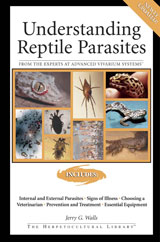The important external parasites in reptiles are mites, ticks, biting flies, and, to a much lesser degree, leeches.
 |
The important external parasites in reptiles are mites, ticks, biting flies, and, to a much lesser degree, leeches. Although many reptile keepers view these external parasites as just a nuisance or an inconvenience, the truth is that they can cause or contribute to very serious pathology. To keep reptiles in captivity and not treat, prevent, and control these pests is foolhardy. The drugs and insecticides used for mites and ticks include ivermectin, dichlorvos (No-Pest) strips, and various pyrethrins and permethrins. The treatments for fly strike (myiasis) and infestation with leeches will also be presented.
It is ironic that a product that has created so much controversy through the years is one of the only products that has been tested and has Food and Drug Administration (FDA) approval for use on reptiles. The original strip was marketed by Shell, and rumors stated that the strips were taken off the market because they were carcinogenic. There were also rumors that France had sued Shell for damages due to cancers induced by the strips when they were used in human hospitals. These rumors simply aren’t true.
The active ingredient of the strips is 2, 2-dichlorovinyl dimethylphosphate, which releases a dichlorvos (organo-phosphate) vapor that has the ability to penetrate even cracks and crevices. The organophosphate acts as a cholinesterase inhibitor, and this leads to an increase in acetylcholine. Norepinephrine and acetylcholine are the two main neurotransmitters in all living animals. In essence, a great imbalance of these two neurotransmitters leads to death. Arthropods have a very primitive nervous system, and even small imbalances of these neurotransmitters are catastrophic to them. The vapor’s effectiveness is enhanced by humidity, which also enhances the life cycle of the reptile mite. The vapor produced is extremely effective against insects, but it was proven safe to reptiles when used as directed. This is a very useful product against reptile mites and for temporary control of biting flies. Although the vapor will kill ticks, this is much slower, and manual inspection and removal of the ticks is more efficient.
Because the vapor produced is an organophosphate, dichlorvos strips are not without potential side effects. Toxicity can, and will, result if the strips are not used as directed. Ventilation is essential to the use of these strips in order to prevent toxic levels from accumulating. There is a common practice among some reptile importers to place newly imported reptiles in a closed garbage pail with a dichlorvos strip for ten to fifteen minutes prior to being placed in an enclosure. In many cases, reptiles have been accidentally left in the closed container for hours. Toxic symptoms included twitching of extremities, ataxia, mental dullness, and even seizures. When placed in fresh air, the reptiles recovered uneventfully, although they could have been treated more effectively with injectable atropine. Some snakes left in closed containers for more than three hours have eventually died. It is also important to prevent the reptile from coming into direct contact with the impregnated strips.
Proper usage is dependent on (1) using a bubble gum–size piece (a 0.2 inch x 2–inch [6 mm x 5–cm] piece cut off of the end of the strip) per 10 cubic feet (283 cubic decimeters), (2) avoiding direct contact with the reptile by placing the piece in a small container with holes, (3) using a strip piece two or three times weekly for six to eight weeks for only two to three hours at a time, and (4) allowing for ventilation in the cage.
Excerpt from the book Understanding Reptile Parasites by Roger Klingenberg with permission from its publisher, Advanced Vivarium Systems, an imprint of BowTie Press. Purchase Understanding Reptile Parasites here.


